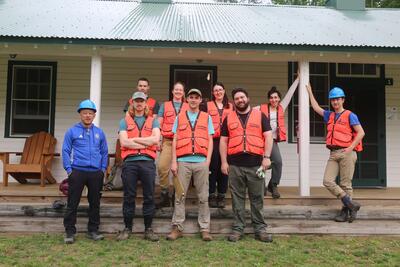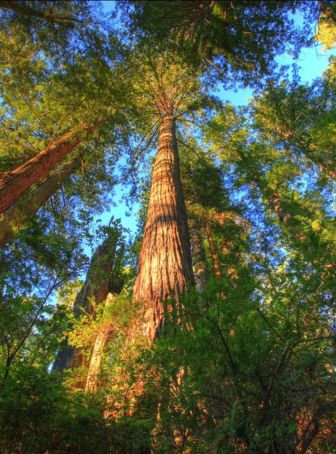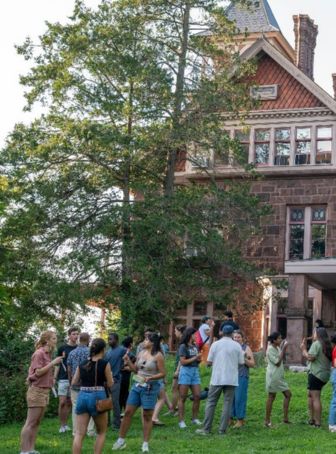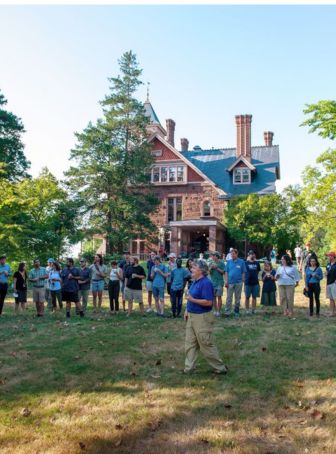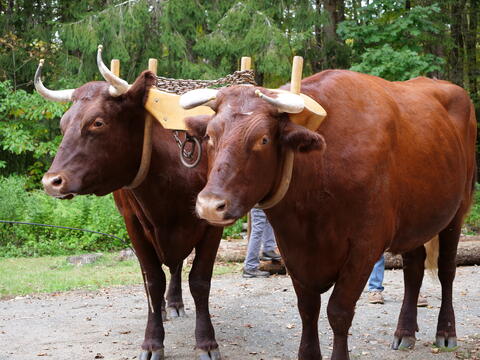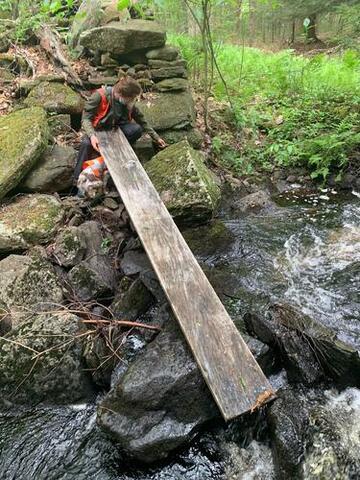
By Emily Sigman ‘21 MF/MA
For decades, intrepid forestry students at Yale have taken part in a time-honored tradition: spending the summer working at the Yale-Myers Forest camp.
To be sure, summertime at Yale-Myers hasn’t always been as structured as it is today. Prior to the early 2000s, a more relaxed tradition existed, in which Master of Forestry (MF) students lived and worked under doctoral student supervision in Yale’s roughly 8,000-acre tract of forestland in Eastford, Connecticut. In the span of the last twenty years, the tradition has evolved into a more formal education curriculum, officially termed the Yale Forests Summer Apprenticeship. Yet to all those who have had the pleasure and the privilege of spending the summer honing their field skills in the Yale Forests—whether in 1947 or 2021—their time is perhaps best and most affectionately remembered by the simple shorthand “Forest Crew.”
For all its varied appellations and manifestations, the quintessence of crew has long remained the same. Forest Crew immerses students in a hands-on learning environment, offering a first-rate field practicum on the science—indeed the art—of land stewardship. This year, under the impressive coordination of Forest Manager Jessica Lloyd ’20 MF, nine students (and five dogs) got the opportunity to spend the summer in the woods of New England and discover what it’s like to be a real-life forester.
Following a safety course in chainsaw use and tree felling at the historic Yale Camp at Great Mountain Forest, the crew reported to the celebrated Yale-Myers Forest camp where they would remain for the next two months. After more than a year of remote learning, the group was more than happy to trade in their laptops for hardhats and head out for a week of laborious roadwork and trail maintenance. Digging ditches, whacking water bars, and clearing culverts were not easy tasks, but silly songs and copious amounts of post-work popsicles kept the group in good spirits, even as torrential rains repeatedly washed out their progress and necessitated repeated work days.
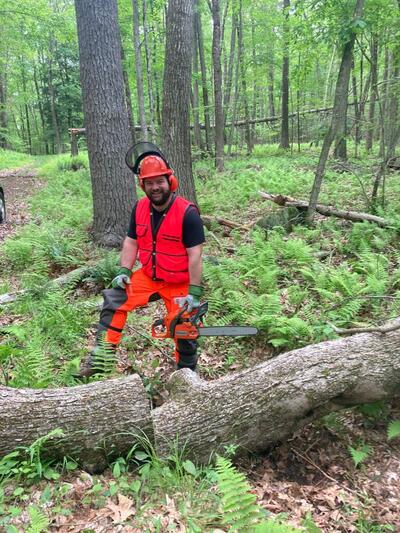
Brad Ward ’23 MF/MBA demonstrates proper chainsaw use clearing a log that had fallen in a path at Yale-Myers. Photo by Jessica Lloyd ’20 MF.
During the next week of Crew, the foresters-in-training got a daily deep dive into a diverse array of disciplines. Dr. Marlyse Duguid led a daylong foray into the forest, equipping the Crew with the ability to identify key plants and trees, and teaching them how to decipher different species of ferns—a useful skill for intuiting soil moisture and predicting how an understory might respond to changes in the canopy. Dr. Kealoha Freidenburg gave a crash course in wetland ecology, treating students to an expert view into the many vernal pools they would encounter throughout the wet summer. Dr. Mark Ashton went all-in on site classification, sharing with students the secrets of soils and land use history, and familiarizing them with no fewer than 63 distinct bird calls.
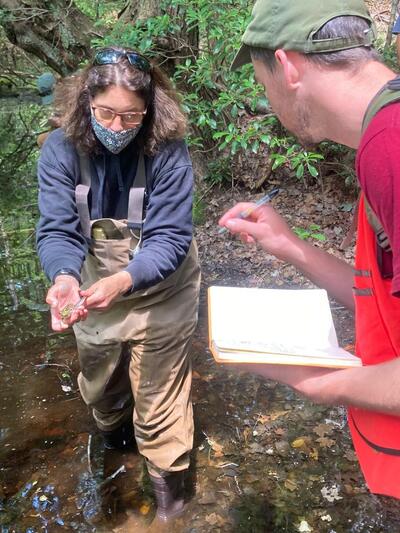
Dr. Kealoha Friedenburg demonstrates how to identify toad and frog species in a vernal pool at Yale-Myers Forest. Photo by Jessica Lloyd ’20 MF.
The following week, Dr. Joseph Orefice and PhD student Reid Lewis ’21 MF unpacked the mechanics of sampling design, walking the crew through the ins-and-outs of forest inventory. Group members with GIS skills adeptly created geo-referenced maps that the Crew used to generate and find randomized plot points. In no time, the Crew was out in the field putting all of their accumulated knowledge to the task of collecting vital information about the forest.
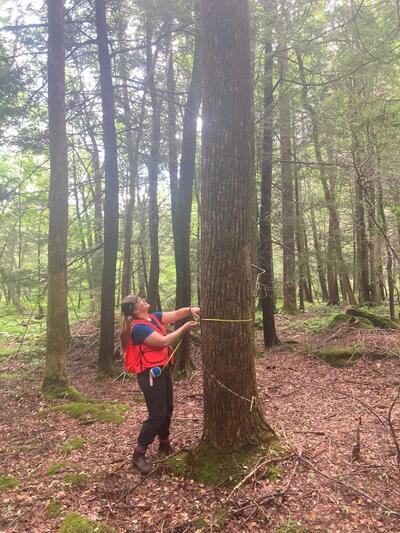
Hannah Andrew ’22 MF/JD measures the DBH of a tree in Yale-Myers Forest. Photo by Jessica Lloyd ’20 MF.
Recognizing that forests are more than data, the group also integrated one minute ‘centering exercises’ into each of their plot points. Prior to spinning an angle gauge or estimating log heights, each team would pick from a list of ten prompts meant to provide space for reflection, stimulate non-linear thought, and foster a more emotional and intuitive connection to the landscape. These prompts can be found here for those keen on experimenting with outdoor centering.
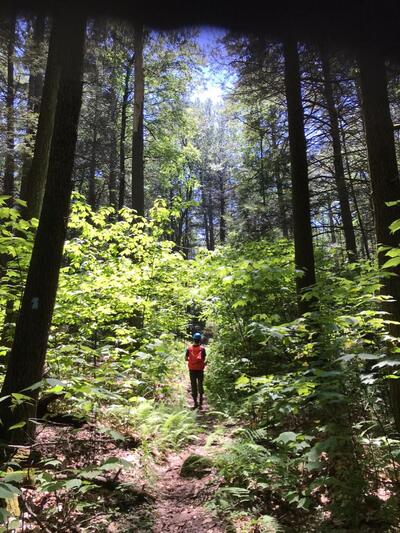
Walker Cammack ’22 MF surveys the forest on a beautiful summer’s day. Photo by Genevieve Tarino ’22 MF.
The group also spent time reflecting on the profession of forestry broadly, especially as it sits within a wider conversation about restoration and environmental justice. Several crew members endeavored to read Dr. Lisa Brooks’ book Our Beloved Kin: A New History of King Phillip’s War (link is external). The book’s contents stimulated repeated discussions and explorations of the relationships between forests, Indigenous nations of the Northeast, and European colonists, and gave the group a more complex and nuanced understanding of the landscapes in which they were studying, working, and living.
Additionally, the Crew grappled with questions of inclusivity, both within the apprenticeship and throughout the field of forestry writ large. Conversations in particular centered on the need for forest crew—and other aspects of forestry education—to evolve in order to be accessible and attractive to aspiring foresters with a range of different physical abilities. The rigorous fieldwork component is, for many, one of the most rewarding aspects of the apprenticeship. By the same token, Forest Crew can be intensely physically demanding, severely restricting who can—and who wants to—participate in this formative program. The vast majority of activities during Forest Crew are prohibitive to wheelchair users and other mobility-restricted people; even the library at camp is not wheelchair accessible.
Many central and requisite components of the forestry degree are similarly restrictive, including the mandatory school-wide Summer Orientation Modules known as MODs, which follows on the tail end of Forest Crew. As a keystone experience, the Yale Forests Summer Apprenticeship has the potential to act as a locus of meaningful intervention and a vehicle through which the Yale Forests and the forestry curriculum can be made more welcoming to a diversity of talents, backgrounds, and experiences. Creativity and continued reflection can hopefully guide future crews towards interventions that allow space for—and even enhance—the existing field components of the summer program.
The depth of these conversations and the intensity of the learning experience were held within a collective and continued commitment to group care. As part of this ethic, the Crew invested energy in co-creating an atmosphere that felt expansive and joyous. Uproarious laughter, spontaneous singing, and mischievous merriment were staples of the Crew’s daily activities, contributing to a palpable air of elation, exuberance, and gratitude. A childlike sense of wonder pervaded time in the field, where the Crew gaped at profuse fungal flushes, admired arboreal abnormalities, and paused to take in the beauty of bird calls. After-work outings to refreshing swimming holes and quaint local creameries quickly became common and cherished rituals.
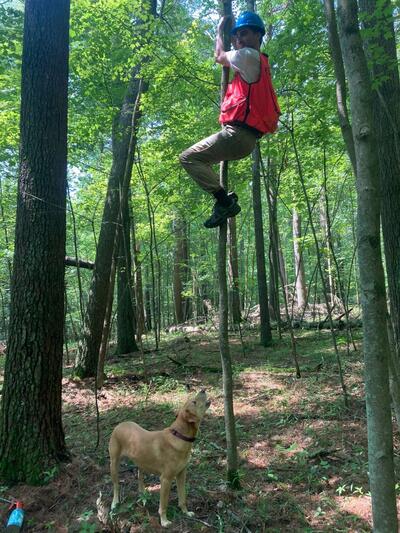
Adam Houston ’21 MEM shimmies up a pole-sized maple tree during a group break. Photo by Hannah Andrew ’22 MF/JD.
In no time, the camp transformed into a near-magical refuge, and the group spent their down-time sharing stories in a not-so-secret treehouse, reading books from the well-curated shelves of the library, and standing in wide-eyed rapture on the porch of the dining hall as the drama of near-daily thunderstorms played out against the silhouette of a sea of trees. The night sky offered itself to constellation-spotting, and the crewmates fell asleep counting their lucky stars.
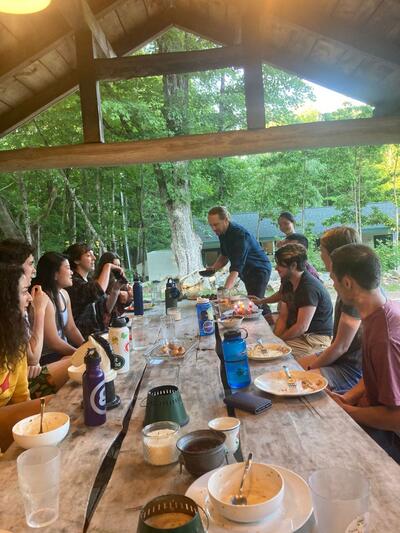
Ryan Smith ’22 MF sits down to the dinner table. The group pooled resources to collectively purchase groceries, which camp chef Eudora Miao ’22 MF prepared every working evening. Photo by Jessica Lloyd ’20 MF.
A balance of seriousness and levity sustained the Crew as they carried out their culminating assignments at Yale-Myers: select stands in the forest deemed appropriate for immediate active management, write comprehensive silvicultural prescriptions, consider operational mechanics, and mark trees for inclusion in timber sales. These were not trivial tasks; the decisions the Crew made would not only dictate which trees would live and which would die, but moreover would set those forest stands on a course that would affect their growth for decades or even centuries.
One of the more remarkable aspects of forestry as it is practiced in the Yale Forests is that foresters typically avoid planting any trees. Instead, foresters become highly attuned to the existing flows of a given site, taking heed of the abiotic and biotic factors present and classifying where a given forest sits within a cycle of stand dynamics. Foresters look for the natural disturbances to which the forest is inherently adapted—such as hurricanes and blow down events in the Yale-Myers Forest—and they work within these adaptations to prescribe treatments that will provoke a regenerative response.
In so doing, trained foresters can promote both ecological and financial sustainability, harvesting marketable timber while also increasing the age-class diversity—and thus resilience—of otherwise fairly homogenous secondary growth forests. Funds from timber sales enable educational programs, such as Forest Crew, while managed forest holdings provision research opportunities in diverse disciplines.
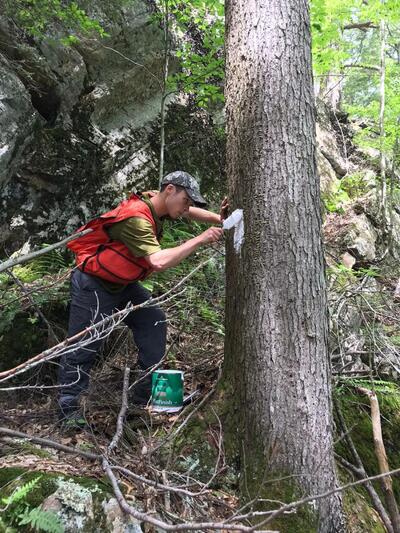
Incoming Forest Manager Matt Valido ’21 MF marks the boundaries of the Yale Forest in the Boston Hollow Division, where the group prescribed a plethora of silvicultural treatments. Photo by Emily Sigman ’21 MF/MA.
Following in this tradition, the group relied on their extensive data collection and qualitative assessments, as well as repeated visits to the stands—often in the company of Dr. Ashton, Dr. Orefice, and Jessica Lloyd—to draw up plans and mark timber in ways uniquely suited to each site. In some stands, for example, the group prescribed a silvicultural treatment known as a crown thinning, in which some trees of marketable value are harvested in order to let other, often more desirable trees grow larger. This treatment accelerates the self-thinning that occurs naturally as a result of light competition.
In other stands, the group chose to use a Femelschlag approach. This technique, sometimes translated from German as an ‘expanding gap shelterwood,’ mimics and exaggerates the effect of a large tree or group of trees crashing down during a storm event. The Crew looked for existing forest canopy gaps where advance regeneration was present in the understory and expanded these gaps outward such that some marketable timber and firewood logs could be harvested, while simultaneously releasing the understory and letting it grow up into the now-open sky.
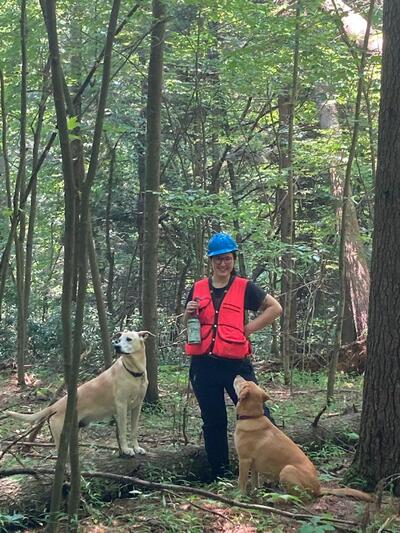
Genevieve Tarino ’22 MF stands ready with a paint gun to mark timber with helpers Toly (left) and Nettle (right). Photo by Adam Houston ’21 MEM.
After completing their work at Yale-Myers, the Crew was put to one final test: condense everything they’d learned that summer into a ten-day intensive trip to Yale’s northern forests. In early August, the Crew bid a fond farewell to their beloved summer home, packed up their tools, and headed north to Vermont and New Hampshire. There, they delineated boundaries, designed a sampling method, and completed a thorough inventory of the Bowen and Crowell Forests in Vermont.
Their sharpened skills in observation and analysis served them well and enabled them to write an updated management plan for these forests. Splitting time between camping in Bowen Forest and staying in rustic accommodations at the historic Yale-Toumey property in New Hampshire, the crew was able to weather unexpected challenges in the field, survive swarms of unrelenting mosquitos, and navigate an unprecedented heat wave to finish the summer with integrity and confidence.
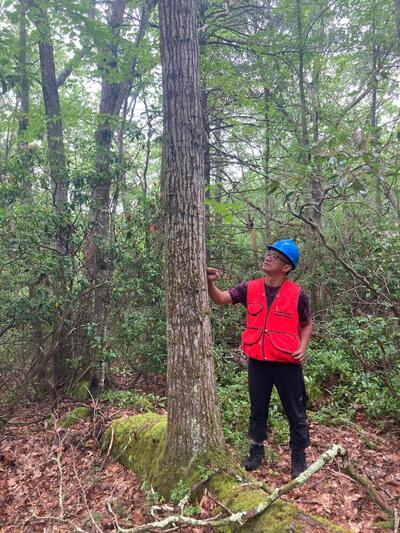
Bijan Gurung ’22 MF stands in a photo for scale. Photo by Jessica Lloyd ’20 MF.
For the crew members involved, the summer of 2021 was more than memorable. The Yale Forests Summer Apprenticeship served each participant as a formative experience, endowing them with new ways of understanding and interacting with both forests and people, and preparing them to thrive in forested landscapes throughout their lives and careers. Once again, the decades-old and yet ever-evolving tradition of Forest Crew saw a new cohort of students graduate, leaving in their wake a new architecture in the forest as a signature and living memory of all they learned and accomplished.
So long as new and diverse students are welcomed into the Yale Forests as apprentices, collaborators and stewards, Forest Crew can continue to make a lasting impact for decades more to come.
The 2021 Forest Crew at Yale-Myers. From left to right, Top row: Matt Valido ’21 MF, Hannah Andrew ’22 MF/JD, Genevieve Tarino ’22 MF, Emily Sigman ’21 MF/MA, Adam Houston ’21 MEM, Bijan Gurung ’21 MF, Walker Cammack ’22 MF, Brad Ward ’23 MF/MBA. Photo by Eudora Miao ’22 MF.
Author bio: Emily Sigman graduated from Yale in 2021 with master’s degrees in Forestry and Global Affairs. Her canine companion, Toly, holds degrees in romping, stick chomping, bagel stealing, and being extremely good. He is the sole non-hominid recipient of Forest Crew’s coveted ‘camper of the day’ award, an Olympic swimmer, and a globally recognized champion of transcendental meditation.
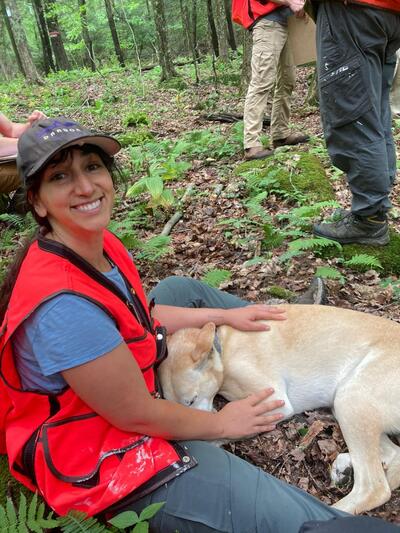
Photo by Hannah Andrew ’22 MF/JD.
